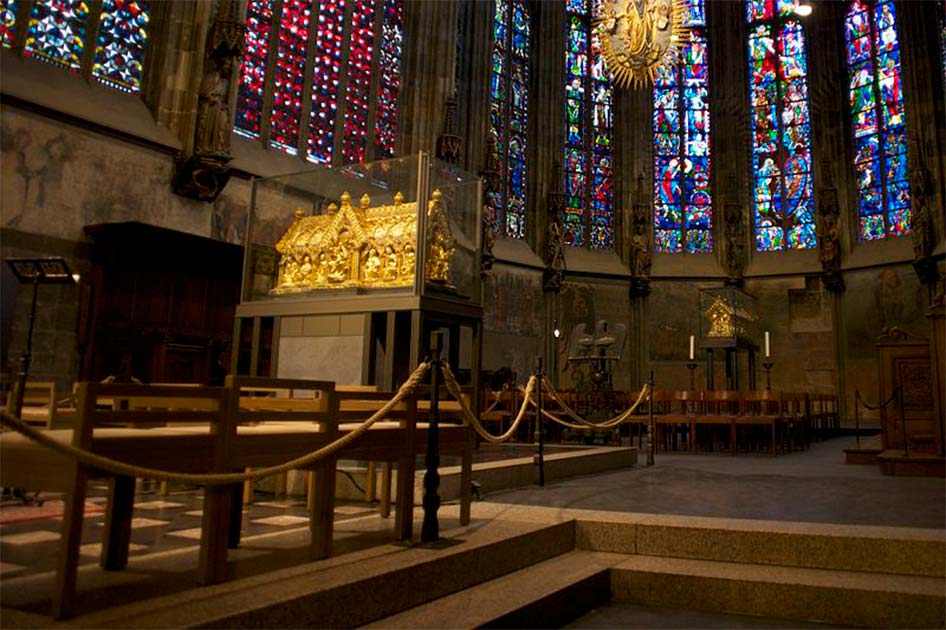Across the globe, there are many chapels and churches that are centuries old and have been considered to be significant examples of a country’s cultural heritage. Buildings like the Boyana Church in Bulgaria that was built in the 10th century, the Church and Dominican Convent of Santa Maria delle Grazie in Italy, where de Vinci’s Last Supper is located, and the White Churches of Vladimir and Suzdal in Russia, are all (almost literally) vital links to our past.
Protecting places like churches, ancient cities, archeological sites, and even concentration camps is done to preserve cultural heritage. Cultural heritage is a thing that demonstrates the people/country’s history and is significant for education or religion.
Organizations like UNESCO protect cultural heritage sites by ensuring they are being cared for, legally protecting the site, can help preserve the site, and more. One of the first sites that UNESCO listed as culturally significant was the Aachen Cathedral of Germany. Why was this cathedral so significant?
Aachen Cathedral
The Aachen Cathedral, located in Aachen, Germany, is one of the oldest cathedrals in Europe. Emperor Charlemagne ordered the construction of the cathedral around 790-800 AD. Charlemagne’s goal was grand indeed: nothing less than the creation of a “new Rome” with Aachen at the center of his empire.

Aachen Cathedral was part of the Imperial Palace, which consisted of the Coronation Hall and the Palatine Chapel. The Palatine Chapel, or the main body of Aachen Cathedral, is built in the shape of an octagon.
When Charlemagne died in 814 AD, he was buried in the Aachen Cathedral, and following the canonization of Charlemagne by Antipope Paschal III in 1165, there was a significant increase in pilgrims who would come to see the church and Charlemagne’s tomb.
The number of people who would pilgrimage to Aachen Cathedral became so overwhelmingly large that a Gothic choir hall was added to the structure in 1355. On the 600th anniversary of Charlegmane’s death, a two-part glass chapel (known as a “capella vitrea”) was built onto the octagonal Aachen Cathedral.
Additional chapels, a cupola, and a steeple were added to the structure before it was restored in 1881. Like many cathedrals in Germany, Aachen Cathedral was heavily bombed during WWII. The basic structure of the chapel survived the bombs and artillery fire, and many of the art objects that were part of the cathedral were removed and placed in storage during the war, so some ancient relics remain today.
- Secrets of the Potala Palace, Winter Fortress of the Dalai Lama
- The Nine Domes of St Basil’s Cathedral and Russian Conquest
The most significant damage to the Aachen Cathedral was the destruction of a large part of the cloister, a Neo-Gothic altar, the glazing style of painting that was seen in the 14th-century choir hall, and the Heilgigtumskapelle (Holiness Chapel) which were “irretrievably destroyed.” The restoration and reconstruction of these damaged parts of the Aachen Cathedral lasted 30 years and cost around €40 Million.
Unique and Irreplaceable
What makes the Aachen Cathedral so unique, besides being one of the oldest chapels in Europe and the resting place of Emperor Charlemagne, is the three distinct styles of architecture found on the site. The main core (Palatine Chapel) was built in the Carolingian-Romanesque style and was modeled after San Vitale at Ravenna.

The choir hall was built in the Gothic style, and some smaller portions were built in the Ottonian style. The Karlsthron, the Throne of Charlemagne, came from recycled spolia from the Church of the Holy Sepulcher in Jerusalem and saw the coronation of 31 German kings and 12 queens.
Emperor Frederick Barbarossa and his wife Beatrice donated a massive golden wheel chandelier that could hold 48 candles that are still lit for the solemnities of the Church. Henry II added an ambon pulpit in the east passage of Aachen Cathedral.
An ambon or ambo is a raised platform where scriptures are read to the congregation. The ambon sits immediately in front of a pair of Holy Doors, which are the central doors of the iconostasis in Eastern Catholic or Eastern Orthodox churches.
Henry II’s ambon is made of oak and covered in decorative filigree, precious stones, four copper repoussé reliefs, and six ivory panels from the 6th century. Historians and artists consider this ambon to be one of the “most significant artistic treasures of the Ottonian Renaissance.”
The, there is the treasury. Home to the Proserpina sarcophagus, where Charlemagne was said to have been buried, the Golden Cross of Lothair, and a bust of Charlemagne, it contains treasures indeed. The Aachen Cathedral Treasury is considered one of the most significant ecclesiastical treasuries in Northern Europe, and the relics are displayed for pilgrims to see every seven years.
UNESCO and their World Heritage Sites
The United Nations Educational, Scientific, and Cultural Organization, better known as UNESCO, is a specialized agency of the United Nations that works to “promote world peace and security through international cooperation in education, arts, and sciences.” UNESCO was created in 1945, and over the years, the organization has developed a list of World Heritage Sites, which the organization legally protects due to its significant role in the history and culture of a country.
One of the first activities that UNESCO undertook, which led to the establishment of the World Heritage List and Committee, was the International Campaign to Save the Monuments of Nubia in 1960. This project aimed to move the Great Temple of Abu Simbel to protect it from being flooded by the Nile River after the Aswan Dam was constructed.
- Machu Picchu Facts – 11 Fascinating Details of the Inca Citadel
- Durendal: Legendary Sword of European History
This campaign lasted 20 years and successfully moved 22 monuments and architectural complexes to safer areas. From then, the organization worked to protect, relocate, or fund the reconstruction of historical monuments and buildings at Mohenjo-Daro, the Acropolis of Athens, Fes, and Kathmandu.

The work with cultural heritage that UNESCO was involved in resulted in the founding of the World Heritage Committee in 1976. In 1978, the World Heritage Committee created a list known as the World Heritage List. The third site on this original list of 12 culturally significant places on the planet was Aachen Cathedral.
A country must nominate a heritage site to a committee that determines if a nominated site is “of outstanding universal value.” To become an official UNESCO World Heritage site, a place must meet one or more of the ten criteria listed below (until 2004, there were six criteria, but it has since been updated):
I. to represent a masterpiece of human creative genius;
II. to exhibit an important interchange of human values, over a span of time or within a cultural area of the world, on developments in architecture or technology, monumental arts, town-planning or landscape design;
III. to bear a unique or at least exceptional testimony to a cultural tradition or to a civilization which is living or which has disappeared;
IV. to be an outstanding example of a type of building, architectural or technological ensemble or landscape which illustrates (a) significant stage(s) in human history;
V. to be an outstanding example of a traditional human settlement, land-use, or sea-use which is representative of a culture (or cultures), or human interaction with the environment especially when it has become vulnerable under the impact of irreversible change;
VI. to be directly associated with events or living traditions, with ideas, or with beliefs, which artistic and literary work of outstanding universal significance. UNESCO requires the committee to consider these criteria with others; it alone does not qualify a site.
VII. to contain superlative natural phenomena or areas of exceptional natural beauty and aesthetic importance;
VIII. to be outstanding examples representing major stages of earth’s history, including the record of life, significant on-going geological processes in the development of landforms or significant geomorphic or physiographic features;
IX. to be outstanding examples representing significant on-going ecological and biological processes in the evolution and development of terrestrial, fresh water, costal and marine ecosystems and communities of plants and animals;
X. to contain the most important and significant natural habitats for in-situ conservation of biological diversity, including those containing threatened species of outstanding universal value from the point of view of science or conservation.
The Aachen Cathedral was assessed as meeting four of the criteria listed above. The first point the cathedral met was Criterion I due to “its columns of Greek and Italian marble, its bronze doors, the largest mosaic of its dome (now destroyed), the Palatine Chapel of Aachen has been perceived as an exceptional artistic creation.”
Aachen Cathedral met the Criterion II as well, “Bearing the strong imprint of both Classical and Byzantine tradition this chapel remained, during the Carolingian Renaissance and even the beginning of the medieval period, one of the prototypes of religious architecture which inspired copies or imitations.”

The Aachen Cathedral met Criterion IV because “The Palatine Chapel of Charlemagne is an excellent and distinctive example of the family of aulian chapels based on a central plan with tribunes.
The final criterion the Aachen Cathedral met was Criterion VI due to “the construction of the Chapel of the Emperor at Aachen symbolized the unification of the West and its spiritual and political revival under the aegis of Charlemagne… The collection of the treasury of the Cathedral is of inestimable archeological, aesthetic and historic interest.”
Aachen Cathedral’s inclusion on the first UNESCO World Heritage List is significant because it was the first site in Europe to be deemed worthy enough of cultural protection from a global organization.
Top Image: Aachen Cathedral. Source: Arnoldius / CC BY-SA 3.0.